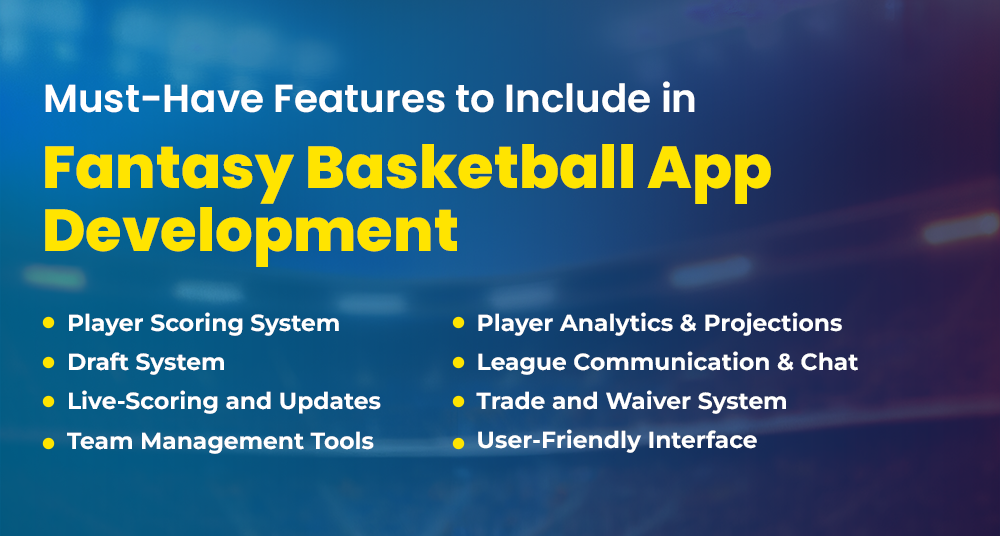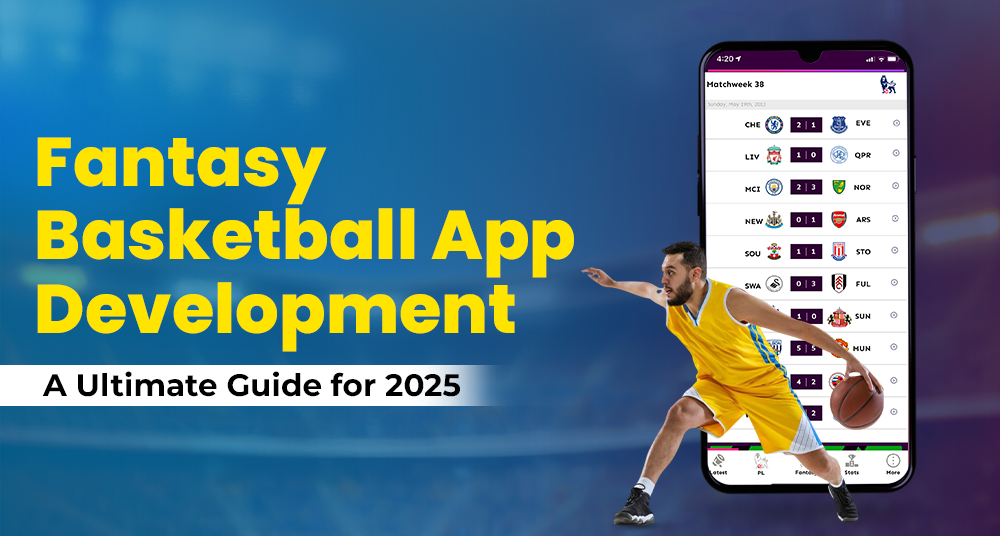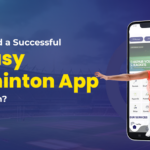Fantasy basketball attracts millions of players each season, making it one of the most popular fantasy sports. As the demand for better and more engaging fantasy sports experiences grows, developers are creating innovative apps to meet users’ needs. If you’re looking to build a white label fantasy basketball app from scratch, this guide will take you through the entire process from initial concept to launch. In this guide, we will explore the key components of fantasy basketball app development, from design to implementation, while considering the user experience (UX), technical architecture, and essential features required for a successful app.
What is Fantasy Basketball?
Fantasy basketball is an online game in which participants assemble imaginary teams of professional basketball players. These teams compete based on the real-world performance of the players in actual basketball games. Points are awarded for different player statistics such as points scored, assists, rebounds, steals, blocks, and other relevant categories.
Fantasy basketball has grown in popularity with major platforms like ESPN, Yahoo Sports, and FanDuel offering various formats for users to compete. With the rise of mobile apps and the increasing interest in sports analytics, there’s a huge opportunity to develop an engaging and user-friendly fantasy basketball app.
Overview of the Fantasy Basketball Market Size
The fantasy basketball market has seen significant growth in recent years, driven by increased fan engagement, digital platforms, and betting integration. With millions of participants globally, it spans both casual and competitive players. The market encompasses daily fantasy sports (DFS), season-long leagues, and related products, offering substantial revenue opportunities.
In 2023, the global fantasy basketball market was valued at USD 4.2 Billion. It is expected to reach at USD 11.2 Billion by 2031 at a compound annual growth rate (CAGR) of 12.2% from 2024 to 2031.
Why Focus on Fantasy Basketball App Development in 2025?
Focusing on fantasy basketball software development in 2025 is strategic due to the sport’s growing global popularity and the increasing demand for immersive, real-time sports experiences. As technology advances, there’s a push for more personalized, data-driven platforms that enhance user engagement. AI and machine learning can improve player recommendations, draft strategies, and game simulations.
Additionally, mobile-first experiences and gamification elements attract younger, tech-savvy audiences. With the NBA expanding its reach internationally, fantasy basketball apps have vast potential to engage new users and integrate features like live stats, social sharing, and in-depth analytics, creating a thriving digital ecosystem.
Key Benefits of Fantasy Basketball App Development
Fantasy basketball app solutions offer a range of advantages, from engaging users to generating steady revenue. As the demand for virtual sports grows, creating a feature-rich app can boost user retention, enhance gameplay, and drive brand loyalty. Here are 8 key benefits of developing a fantasy basketball app.
Engagement and Retention
-
Continuous User Engagement: Fantasy sports apps keep users engaged throughout the basketball season, offering features like live scoring, player updates, and trade options. This constant engagement boosts retention rates.
-
Real-Time Interaction: In-app live statistics, scores, and updates encourage users to frequently check in, fostering daily or weekly interaction.
Monetization Opportunities
-
Subscription Models: You can offer premium features such as advanced player statistics, analytics, or exclusive leagues for a subscription fee.
-
In-App Purchases: Users can buy virtual goods like extra points, boosters, or entry fees for special leagues.
-
Ads & Sponsorship: Partnering with brands or advertisers in the sports industry can provide ad revenue.
User Community Building
-
Social Features: Features such as leaderboards, social sharing, and group chats build a sense of community and competition among users.
-
Custom Leagues and Tournaments: Allowing users to create custom leagues, invite friends, and organize their own tournaments fosters stronger social bonds and loyalty.
4. Data Analytics and Insights
-
In-depth Analytics: Fantasy apps can provide users with detailed statistics and performance analytics, helping them make better decisions for their teams.
-
Personalized Suggestions: By analyzing player stats, trends, and user behavior, the app can suggest optimal players, trades, and strategies.
Seasonal or Year-Round Revenue Streams
-
Seasonal Play: Fantasy basketball apps can run as seasonal businesses, with high activity during the NBA season, allowing for targeted marketing and events around key moments like the NBA Draft, playoffs, or All-Star weekend.
-
Off-season Engagement: Integrating features for off-season activities, like mock drafts or fantasy basketball updates, can maintain user interest year-round.
Cross-Platform Compatibility
-
Mobile and Desktop Access: Fantasy basketball apps can be developed for both mobile devices and desktop platforms, expanding their reach and providing flexibility for users.
-
Integrated with Other Fantasy Leagues: Some users may enjoy participating in multiple fantasy leagues, so integration with other sports fantasy apps can increase usability and attract a broader audience.
Customization and Personalization
-
Customizable Leagues: Users can create and manage their own leagues with specific scoring rules, player restrictions, and formats.
-
Personalized Experience: Tailoring the app experience based on player preferences, favorite teams, or past performance helps users feel more connected to the platform.
Scalability and Growth Potential
-
Global Reach: With basketball being a global sport, a well-developed fantasy basketball app can appeal to a wide audience across various regions.
-
Scalable Features: As user demand grows, you can easily add more features, like support for multiple languages, custom scoring systems, and advanced player analytics.
Brand Building
-
Brand Loyalty: A successful fantasy basketball app can generate significant brand loyalty and recognition, especially if it provides a unique experience or innovative features.
-
Collaboration with Sports Networks: Collaborating with sports networks, players, or teams could enhance the app’s visibility and credibility.
Fantasy Sports Culture Expansion
-
Growing Popularity: Fantasy sports have seen rapid growth, and basketball is one of the most popular sports in this area. Developing a fantasy basketball app taps into this growing market.
-
Social & Cultural Impact: Fantasy basketball can enhance fan culture, connecting people to the game on a deeper level and creating communities based around their teams and players.
Key Features to Include in Fantasy Basketball Software Development

When developing a white label fantasy basketball app, certain key features are essential for providing an engaging, user-friendly experience. These elements ensure players can manage their teams efficiently, track performance, and engage in competitive play. Below are eight crucial features that will elevate the overall functionality and enjoyment of your fantasy basketball platform.
Player Scoring System
The scoring system must be customizable to fit different league formats (points, categories, or dynasty). It should calculate real-time player performance based on various stats like points, assists, rebounds, steals, and blocks, ensuring players can track their team’s progress and make informed decisions throughout the season.
Draft System
An intuitive draft system is crucial for team selection. It should support various formats like snake drafts or auction drafts, offering real-time updates, player rankings, and strategic recommendations. Features like automatic player suggestions and time limits per pick help maintain pace and make the drafting experience engaging and smooth.
Live Scoring and Updates
Live scoring gives users real-time information on player performance, making it essential for fantasy team managers to react instantly. The system should update frequently, integrating official NBA statistics, and deliver notifications on player injuries, trades, or other news that could affect their fantasy lineup decisions.
Team Management Tools
Easy-to-use team management tools are vital for users to make quick adjustments. These features should include options for trades, waivers, benching players, and setting starting lineups. Additionally, providing injury reports, player projections, and matchup analysis helps managers make better strategic decisions every week.
Player Analytics & Projections
Incorporating detailed player statistics, trends, and predictive analytics adds tremendous value. Real-time insights into a player’s historical performance, upcoming matchups, and injury history allow fantasy managers to optimize their rosters, trade effectively, and make data-driven decisions to gain an edge over their competition.
League Communication & Chat
Incorporating a messaging and chat feature enables users to engage with league members. This fosters a more competitive and social atmosphere by allowing managers to negotiate trades, trash talk, or collaborate on league decisions. Integrated messaging can also be used for league-wide announcements or rule clarifications.
Trade and Waiver System
A flexible trade and waiver system is crucial to keep the league dynamic. The software should allow players to propose, accept, or veto trades, as well as set up automatic or manual waiver claims. Trade approval systems and deadlines should be incorporated to ensure fairness and prevent potential abuses.
User-Friendly Interface
The design and usability of the platform are essential for attracting and retaining users. The interface should be intuitive, easy to navigate, and mobile-friendly. Simple tools for roster management, player search, and performance tracking will enhance user experience, ensuring the software remains accessible even to beginners.
Fantasy Basketball App Development Process: From Vision to Execution

Developing a fantasy basketball app involves a structured process, starting from initial planning to post-launch marketing. Key stages include market research, defining core features, creating wireframes, selecting technology stacks, incorporating gamification, ensuring security, rigorous testing, and effective marketing. Here’s a breakdown of each step to create a successful app.
Initial Planning and Market Research
Before development, thorough planning and market research are crucial. This involves understanding the target audience, competitor analysis, and identifying current market gaps. Gathering feedback from potential users helps shape the app’s vision, while competitor insights allow developers to incorporate features that stand out, ensuring the app addresses real user needs and preferences.
Defining Core Features and Functionalities
Core features should align with user expectations. For a fantasy basketball app, key functionalities include player stats, team management, live scoring, and trade systems. Additionally, features like leagues, real-time notifications, player news, and social interactions increase engagement. Properly prioritizing these features based on user demand is essential for a successful app experience.
Wireframing and Prototyping
Wireframing and prototyping help visualize the app’s layout and flow. Wireframes provide a blueprint for app structure, highlighting essential screens and navigation pathways. Prototypes add interactivity, allowing stakeholders to experience a near-real version of the app. This phase helps identify usability issues early, ensuring a smooth user interface (UI) and user experience (UX) design.
Technology Stack and Development
Selecting the appropriate technology stack is essential for optimizing your app’s performance and ensuring it can scale efficiently as your user base grows. For a fantasy basketball app, technologies like React Native or Flutter for cross-platform development, Node.js for backend, and cloud services for data storage are popular choices. Integrating APIs for live sports data and using a robust database like PostgreSQL ensures seamless operation and user experience.
Gamification and Engagement
To keep users engaged, gamification is vital. This includes features like leaderboards, achievements, daily challenges, and rewards. Points, badges, or prizes for performance-based milestones increase retention and enhance user experience. Interactive elements, such as weekly tournaments or fantasy draft events, create excitement and foster a sense of community among users.
Security and Compliance
Security is essential, especially when handling user data and transactions. Implementing encryption, two-factor authentication (2FA), and secure payment gateways ensures user data is safe. Additionally, compliance with data protection regulations like GDPR and CCPA is crucial. Adopting secure coding practices and regular security audits helps maintain trust and safeguards user privacy.
Testing and Quality Assurance (QA)
Comprehensive testing ensures the app works as expected. This includes unit testing, integration testing, performance testing, and user acceptance testing (UAT). QA teams focus on identifying bugs, usability issues, and performance bottlenecks, while automated testing tools help streamline the process. Regular testing ensures a bug-free, high-quality app at launch.
Launch and Marketing
Launching the app requires effective marketing strategies to attract users. Creating buzz before launch through social media, influencer partnerships, and email campaigns can drive initial installs. Post-launch, maintaining user engagement through regular updates, in-app promotions, and community-building efforts ensures continued growth. Analytics tools help track user behavior for future improvements.
Cost to Build a Ready to Go Fantasy Basketball App
The cost of developing a fantasy basketball app can vary widely depending on factors like features, platform (iOS, Android, or both), and complexity. A basic app with standard features such as player stats, live scores, and draft capabilities may cost between $7000 to $10000. More advanced apps with features like AI-driven player suggestions, detailed analytics, or real-time updates could increase the cost. Additional costs may include maintenance, updates, and marketing.
Why Choose Fantasy App Solutions as Your Fantasy Basketball App Development Company?
Choosing Fantasy App Solutions as your Fantasy Basketball App Development Company can offer numerous advantages, particularly if you’re aiming to create a high-quality, engaging, and user-friendly app for fantasy basketball enthusiasts. Here are several compelling reasons why you should consider Fantasy App Solutions for your project:
Expertise in Fantasy Sports App Development
Our team has extensive experience in developing fantasy sports apps, with a deep understanding of player statistics, game mechanics, and user engagement strategies. This expertise ensures that your fantasy basketball app is built with precision, optimized for seamless performance, and provides users with a captivating experience that keeps them coming back.
Customizable Solutions
We believe that every fantasy basketball app should reflect the unique needs of its brand. Our development process offers fully customizable solutions, allowing you to tailor features, UI/UX design, and functionality. Whether you’re looking to add innovative features or adjust game mechanics, we work closely with you to create an app that meets your exact specifications.
Scalable and Robust Platform
As your user base grows, so should your app’s capacity. Our development process focuses on building scalable platforms that can handle an increasing number of players, teams, and data processing needs. With a strong, future-proof architecture, your app will be able to expand seamlessly, ensuring a smooth experience for all users, no matter how large your community grows.
Cost-Effective Solutions
We recognize the need to strike a balance between quality and affordability. Our strategy focuses on delivering top-tier fantasy basketball apps at a price that won’t break the bank. By utilizing streamlined development techniques and scalable technologies, we ensure cost-effective solutions that maintain high standards for performance, security, and user experience.
Proven Track Record
With a strong portfolio of successful fantasy sports apps, our company has built a reputation for delivering exceptional products. We’ve partnered with a diverse range of clients, assisting them in launching apps that engage and retain users. Our extensive experience across all phases of app development guarantees that your project will be handled with expertise and care.
Post-Launch Support and Maintenance
Our commitment to your project doesn’t end once the app is live. We offer ongoing post-launch support and maintenance to ensure that your fantasy basketball app runs smoothly. From troubleshooting technical issues to rolling out regular updates and new features, we’re dedicated to keeping your app up-to-date and optimized for long-term success.
Useful Resource: “Fantasy Hockey App Development Guide“
Wrapping Up
Developing a fantasy basketball app offers significant opportunities to tap into a rapidly growing market. By focusing on key features like real-time data integration, user customization, and engaging gameplay elements, you can create an app that stands out in the competitive fantasy sports landscape. A well-executed app can foster user loyalty, drive monetization, and scale with increasing demand. Partnering with an experienced development team ensures that your app is built with precision, scalability, and security, setting it up for long-term success in the ever-evolving fantasy basketball industry.



